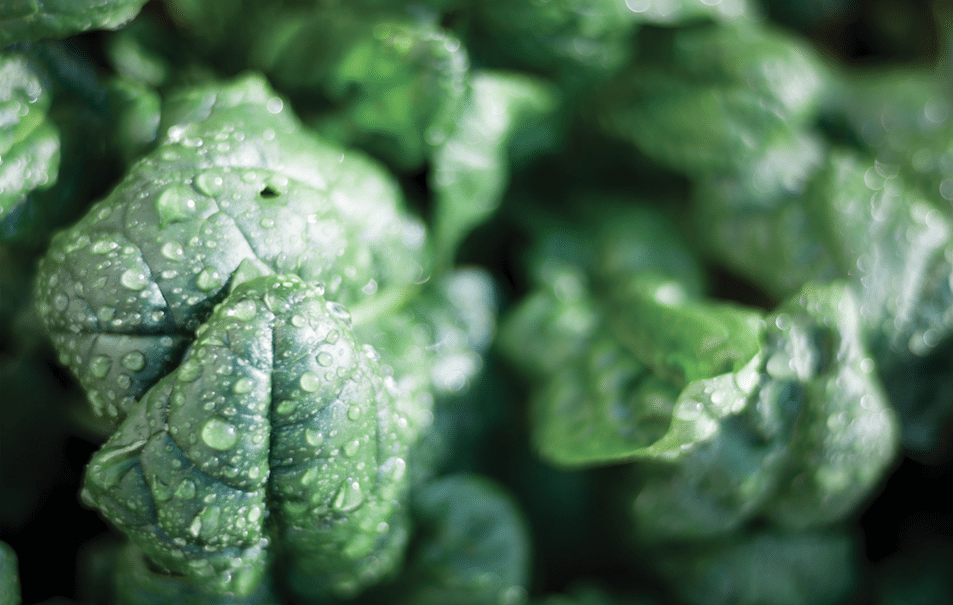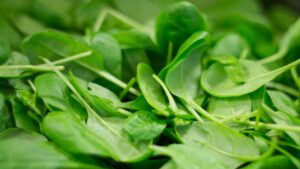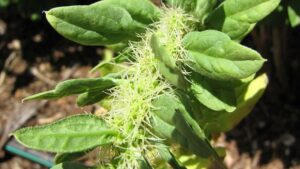New genomic information may lead to improvements for a traditional health food.
At trendy salad bars, spinach vies with kale as king of the leafy greens. Long regarded as a nutrient-rich vegetable, spinach is replacing traditional salad lettuce with little nutritional value as a component of prepackaged fresh, leafy green salad mixes. It is now a year-round staple for health-conscious consumers.
One reason for spinach’s popularity is its high nutrient content. According to the George Mateljan Foundation, spinach is the No. 1 food source of magnesium and iron and the No. 2 food source of several vitamins including B2, B6, E and K. Spinach is also a significant source of folic acid, calcium, potassium and vitamin A.
Spinach Production
Spinach falls into three types: savoy, semi-savoy and flat leafed with many cultivars of each. Savoy types are very productive and handle cold better than others. They have deeply crinkled leaves and a low growth habit that makes cleaning its leaves a chore. Semi-savoy spinach types have a more upright habit that makes mud splash less likely. Flat-leaf types have smooth, flat leaves that are easier to clean, which makes it the primary choice for processed spinach.
“Baby spinach” is a term typically used to describe spinach that has been harvested during an early stage of plant growth, usually 15-35 days after planting. It is favored for its small leaves, tender texture and sweet taste in comparison with mature, fully-formed spinach leaves.
Research shows that the concentration of nutrients in spinach is variable. Some studies conclude nutrients such as vitamin C, carotenoids and flavonoids are more concentrated in baby spinach leaves than in mature spinach. Other studies report the opposite. Nutrient variation appears to be the result of differences in the soil, season and climate in which the spinach is grown.
The U.S. Department of Agriculture (USDA) reports U.S. growers in 2017 harvested over 53,000 acres of spinach. California growers harvested 60 percent of the crop while Arizona growers harvested 24 percent.
China produces 85 to 90 percent of the total global spinach crop depending on the year. The U.S. is second largest producer with 2 to 3 percent of the world’s production.
Plant Breeding Priorities
Although U.S. spinach consumption has leveled in the past five years, plant breeders continue to aggressively seek to develop new hybrids. High on breeders’ priority list are resistance to three important diseases that affect spinach production: downy mildew, white rust and Fusarium wilt.
Downy mildew is the most widespread and destructive spinach disease throughout the world, especially in California and Arizona. Though fungicide applications are available to control downy mildew in conventional production, adequate control measures are not available for organic production.
New biofungicides continue to be evaluated to control downy mildew. More than 30 materials have been tested either in the field or under greenhouse conditions, but none of these materials effectively reduce downy mildew to commercially acceptable levels.
While downy mildew is a soilborne disease, USDA researchers at Salinas, Calif., in 2015 found fertilized spores in 9 percent of the seed lots they tested indicating the disease is also seed borne.
“The transport and spread of downy mildew on seed is a concern since the oospores can survive up to three years,” says Steve Klosterman, USDA research molecular biologist. “More work is necessary to determine if the viable oospores detected on spinach seed can infect spinach seedlings.”
Induced systemic resistance by beneficial microbes is a technique that could be an important method for downy mildew control, especially for organic production. Using selected plant growth-promoting bacteria and fungi, a plant can be preconditioned to resist infection in much the same way animals can be vaccinated to resist infection. If the spinach defense mechanisms can be triggered before the plant becomes infected, disease intensity can be reduced.
“Resistance to downy mildew is the only method available to control downy mildew in certified organic production,” says Jan de Visser, Pop Vriend Seeds spinach breeder, the Netherlands. “The increase in consumption of spinach plus consumers’ perception that organic foods are healthier than conventionally-raised foods have caused growers to intensify production. Instead of raising a spinach crop once every two or three years in the same field, growers are raising spinach year after year with no crop rotation.
“This more intense production increases the rate at which downy mildew produces new races,” de Visser says. “For plant breeders, it has become a race to develop new varieties with resistance to the new fungal races before the fungus overcome the resistance in older spinach varieties.”
Downy mildew disease pressure was high in the 2016-17 growing season in both California and Arizona. A new race in 2016 was confirmed and designated race16. Established plant resistance is breaking down. Several novel fungal races, which are now able to infect race 1-15 resistant and race 1-16 resistant spinach varieties, have been identified and are currently being further evaluated. Additional isolates are being evaluated by the International Working Group on Peronospora (a class of plant pathogens similar to true fungi) and could potentially be designated as new races downy mildew.
Lower Cadmium uptake
California’s Salinas Valley has areas with usually high levels of cadmium (Cd) in bedrock and agricultural soils. Charles Brummer, University of California, Davis, is leading a project to develop baby leaf spinach with lower Cd uptake. His team obtained over 700 accessions across three germplasm collections (USDA-National Clonal Germplasm Collection, the Centre for Genetic Resources (CGN), the Netherlands, and Leibniz Institute of Plant Genetics and Crop Plant Research (IPK), Germany) plus commercial F1 hybrids and open pollinated cultivars.
“After making additional selections for further testing and potential use in our breeding program, we will determine DNA sequence diversity in candidate genes associated with low cadmium accumulation,” Brummer says. “We will then begin hybrid development between low Cd lines and breeding populations to incorporate the trait into cultivars to enable genetic mapping of genes associated with Cd uptake.”
Salinity and Nutrient Deficiency
Salinity and nutrient deficiency are production constraints in all major spinach districts of California. Salt-tolerant spinach varieties have been identified by Beiquan Mou, USDA research plant geneticist, and Chenping Xu, research plant physiologist at the USDA research facility at Salinas, Calif. These cultivars are available to breeders for crop improvement.
The scientists found that salinity significantly decreased plant growth and leaf water content and increased chlorophyll content. Salt stress actually improved nutritional value by increasing carotenoid and flavonoid contents. Nitrogen deficiency greatly reduced plant growth and chlorophyll content, but increased anthocyanin and phenolic contents regardless of salt treatment.
Phosphorus and potassium deficiencies decreased plant growth irrespective of salinity treatment, but increased chlorophyll content under no-salt conditions. These deficiencies increased carotenoid and flavonoid contents without salinity stress.
“These results suggest that reduced fertilizer application or mild salt stress might be used to improve the nutritional value of spinach with moderate or little yield reduction,” Mou and Xu say.
Opening Doors for Future Genetic Improvement
Several recent developments are opening doors for genetic improvement. One major advancement is the sequencing of the spinach genome.
A new spinach draft genome was published late in 2017 by a collaborative team of researchers from Boyce Thompson Institute (BTI) at Cornell University and China’s Shanghai Normal University. The authors sequenced the RNA transcriptomes of 120 cultivated and wild spinach plants, which has enabled them to identify which genetic changes have occurred through spinach’s domestication process.
“The spinach genome sequence and transcriptome variants developed in this study provide valuable information that can be used to breed spinach with better disease resistance, higher yield and better quality,” says Zhangjun Fei, the project’s lead researcher from BTI. “Breeders can use the new genomic information to speed up improvements to combat diseases, like downy mildew.”
Researchers have already identified several genes that may confer resistance to the downy mildew pathogen.
Of particular interest to researchers is the discovery that the genomes of cultivated spinach varieties are not too different from their wild progenitors. “By analyzing transcriptome variants of a large collection of cultivated and wild spinach accessions, we found that unlike other vegetable crops, such as tomato and cucumber, spinach has a weak domestication bottleneck,” explained first author, Chen Jiao.
This means there may still be considerable room for spinach improvement, but it also makes it more difficult to pinpoint genomic markers that could speed up the breeding process. Nonetheless, the team has identified regions in the genome that could be linked to valuable traits, such as bolting and leaf stem length.
Whether or not researchers are able to use new genomic information to identify and develop yielding, disease resistant spinach varieties, spinach’s reputation as a healthy, nutrient-dense, green leafy vegetable is solidly in place. And whether or not Popeye the Sailor Man’s strength to defend Olive Oyl came from his love of spinach, millions of health conscious consumers are certain to continue their devotion to baby leaf spinach.













